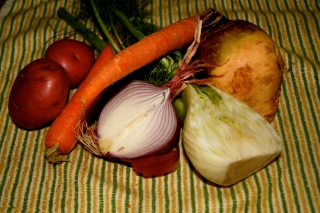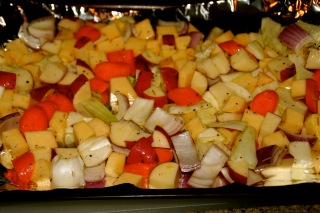
In an attempt to expand my mental pantry, I’m going to be selecting an ingredient each week to highlight right here on this blog. These explorations will likely feature something I’ve never or hardly ever used in my cooking that I may come across at the market or read about on a food blog or book.
To start this project I’d like to introduce you all to fresh turmeric. I found this root ingredient at the Aspen Emporium and Flying Circus the other day while I was picking up some produce. At first glance I thought it was ginger root because of the similarity in skin and appearance. Upon closer look though, I was able to distinguished turmeric by its deep orange color underneath the skin as well as it’s smaller size and less nobby shape in comparison to ginger. I’ve seen ground turmeric among spice selections at most markets, and in fact have some in the spice cupboard here at home, but fresh turmeric root is something new and entirely different from it’s dried and ground counterpart. You can find ground turmeric in the spice aisle of most supermarkets, but fresh turmeric can be more difficult to find. Believe me, it’s worth the hunt.
If you know the difference in flavor between ground ginger and fresh ginger or garlic powder and fresh garlic, then you can understand why fresh turmeric was an exciting find for me. The freshly grated adds a mild, earthy and almost refreshing flavor to dishes that the dried version absolutely lacks, without being overpowering. I was warned before purchasing that it is commonly used as a coloring agent in cooking, acting as a naturally yellow dye to many of the products we see in the grocery store today: mustards, curry powders, etc. After having cooked with it rather carelessly, I now know what they were talking about: the dye is so powerful that it actually stains your skin yellow when you handle it. For both color and flavor it is an essential component in curries and thus a staple ingredient many Indian, Moroccan and Middle Eastern dishes.

Parsnips, brussel sprouts and red jalapeno with fresh turmeric (check out that color!) served over brown rice with a farm greens salad (these greens were brought home from CRMPI)
Aside from color and flavor, (fresh) turmeric contains the active ingredient curcumin which boasts some incredible health benefits. Research suggests that in addition to it’s high antioxidant content, it is also purported to aid in anti-inflammation, lower both blood sugar and cholesterol levels, and may even prevent certain types of cancers. Other benefits of turmeric (curcumin) include stomach-soothing, antibacterial and liver detoxifying properties. For these reasons, curcumin can now be found in many health food and alternative medicine stores in powder and pill forms for supplemental use.
Below are two simple recipes featuring fresh turmeric:
Turmeric Kale Chips

Ingredients:
- 3 or 4 leaves of kale, rinsed, stems removed and roughly chopped (I brought these home from CRMPI)
- drizzle of olive oil
- generous grating of fresh turmeric
- kosher salt and pepper to taste
- dried chili flakes (optional)
Preheat oven to 425. In a large bowl, combine all ingredients and mix well to incorporate the oil and spices evenly onto the kale pieces. 
Spread kale on baking sheet and spread out so that the leaves are overlapping as little as possible. 
Bake for 45 to an hour, until the leaves are dried and crispy without any sogginess. They should not be brown or burnt but rather take on a darker green hue. Remove from oven, allow to cool for five minutes, and enjoy.
Deviled Farm Eggs with Fresh Turmeric
I was reminded of my love for deviled eggs at The Cheese Shop’s Farm-to-Table Dinner (they used duck eggs) a few weeks ago, and going by the fairly traditional recipe of curried deviled eggs I was inspired to create my own version using freshly grated turmeric.

Ingredients
- However many farm eggs you’d like (For a snack portion, I used two of the farm eggs I took home from CRMPI)
- Mayonnaise, aioli, or anything similar (Vegannaise is also a great healthier option)
- Dijon mustard
- Generous grating of fresh turmeric
- half a scallion, minced (can also use garlic, onion or shallot), also a few more slices for a nice garnish
- dash of dried chili flakes to taste (you can also use a hot sauce like Tabasco or Cholula if you like the heat)
- kosher salt and pepper to taste
- paprika, for garnish
First you must hard boil the eggs. To do this place the eggs in a saucepan and fill with water so as to immerse the eggs entirely in the water. Bring the water to a boil on high heat, simmer at a boil for a minute and then turn the heat down low and let simmer for fifteen or so minutes. My eggs actually took over a half hour simmering, because I live at 8500 feet and they still were just barely cooked through at the fifteen minute mark. I personally would recommend allowing the eggs to simmer for longer than instructed, but the only way to know is to sacrifice an egg, peel it open and if it’s ready, great; if not, keep them simmering and, alas, savor that soft-boiled deliciousness. Once the eggs have been cooking for as long as your patience can handle, drain the hot water and re-fill the saucepan with cold water (a few ice cubes speed up the cooling proces) and allow to sit for about 10 minutes as this will ease the already difficult task of peeling the eggs.
Once peeled, slice eggs in half and separate the yolks from the whites. In a bowl, combine yolks with mayo, mustard, fresh turmeric, scallion, chili flakes, salt and pepper, using a fork to mix and incorporate all ingredients. The mixture should become silky and soft, rather than chunky, after a few minutes of mixing. Spoon or pipe the mix back into the whites and top with some sliced scallions and a sprinkle of paprika.
I encourage you all to get out there and give fresh turmeric a try for yourself. Besides these recipes, I would suggest adding freshly grated turmeric to simply sauteed veggies, or incorporating it into traditional recipes for those extra little kicks of flavor, color, and sheer nutritional value.
 I never expected to find myself at a lake in the middle of Michigan. I never expected to fall in love with this place either, let alone visit here at all. But I did, three times over.
I never expected to find myself at a lake in the middle of Michigan. I never expected to fall in love with this place either, let alone visit here at all. But I did, three times over. The lake is called Higgins, and it’s where the Gillespie family has called their summertime home for over three generations.
The lake is called Higgins, and it’s where the Gillespie family has called their summertime home for over three generations. With each visit I am shown again of the unwavering generosity and warmest of welcomes.
With each visit I am shown again of the unwavering generosity and warmest of welcomes. To visit Lake Higgins is to take a step back in time, to a slower pace unconcerned with life’s most consuming trivialities. Anyone is invited, everyone pitches in, and nobody’s counting. Out there, it’s about the simplest forms of enjoyment, and enjoyment there is to be had. It’s a gift alone to be a part of it.
To visit Lake Higgins is to take a step back in time, to a slower pace unconcerned with life’s most consuming trivialities. Anyone is invited, everyone pitches in, and nobody’s counting. Out there, it’s about the simplest forms of enjoyment, and enjoyment there is to be had. It’s a gift alone to be a part of it. I followed the recipe once I returned home to Portland.
I followed the recipe once I returned home to Portland.
 Add salt to water, combine and add to vegetables. Let sit overnight. Drain and rinse lightly.
Add salt to water, combine and add to vegetables. Let sit overnight. Drain and rinse lightly.








































 Now my dad, the grillmaster and “all-knowing chef de cuisine” in our family, is one of the few people in my life who’ve had a significant impact on my passion for cooking, so naturally it was he who spearheaded the dinner. He prepared a roast pork loin.
Now my dad, the grillmaster and “all-knowing chef de cuisine” in our family, is one of the few people in my life who’ve had a significant impact on my passion for cooking, so naturally it was he who spearheaded the dinner. He prepared a roast pork loin.
 Did you know that my sister Kyle is an awesome cook too? Because she is. Now she might not keep a blog to blabber on about every little thing she cooks, but there is one thing that’s for sure: girl can get down with some roasted eggplant. As a side dish, she sliced the eggplant in circular half inch slices, coated them in olive oil, salt and pepper and then pan roasted them until soft. Normally I don’t think to cook with eggplant, but after having eaten it this way I made the decision to incorporate it into more of my cooking in the future. She also sauteed some onions that we combined with
Did you know that my sister Kyle is an awesome cook too? Because she is. Now she might not keep a blog to blabber on about every little thing she cooks, but there is one thing that’s for sure: girl can get down with some roasted eggplant. As a side dish, she sliced the eggplant in circular half inch slices, coated them in olive oil, salt and pepper and then pan roasted them until soft. Normally I don’t think to cook with eggplant, but after having eaten it this way I made the decision to incorporate it into more of my cooking in the future. She also sauteed some onions that we combined with 






